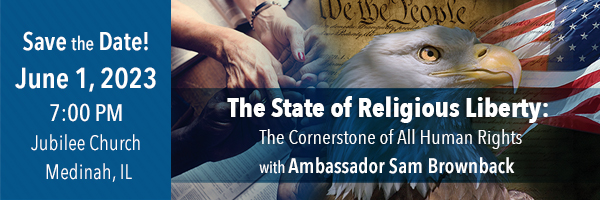Legalizing Assisted Suicide is Reprehensible
There is a terrible proposal in Springfield being shopped around behind closed doors – a bill to legalize assisted suicide in Illinois. Certain members of the Illinois General Assembly are trying to rush a measure through so that the Governor can sign it into law, but is this a good idea? What does the Bible say about such things?
There are a number of examples of suicide that are recorded in the Bible and they are all tragic and terrible. King Saul threw himself on his own sword in 1 Samuel 31 after the LORD declared that the Kingdom would be taken from him and given to David. King Zimri is another example. 1 Kings 16:18-19 tells us,
“When Zimri saw that the city was taken, he went into the citadel of the king’s house and burned the king’s house over him with fire, and died, because of his sins which he sinned, doing evil in the sight of the Lord, walking in the way of Jeroboam, and in his sin which he did, making Israel sin.”
And who can forget the most famous account of suicide in the Bible, when Judas after his betrayal of Christ went and hanged himself (Matthew 27:5).
In these, and other accounts, the Bible makes it very clear that suicide is sin. Life is precious, and life has sanctity because God is the Author of it. Our own lives are not ours to take whenever we wish. They belong to God, and God determines when life begins and ends, not us. Listen to the words of Deuteronomy 32:39,
“See now that I, I am He, And there is no god besides Me; It is I who put to death and give life. I have wounded and it is I who heal, And there is no one who can deliver from My Hand.”
And again in 1 Samuel 2:6,
“The LORD kills and makes alive; He brings down to Sheol and raises up.”
Do you see that? GOD ALONE has authority over life and death. GOD ALONE is able to take life and give life. He is the Author of Life!
Scripture does not give us license to take our own lives. Suicide is self-murder, and murder is always wrong. Those who say that people should have the right to go to a physician to assist them in killing themselves are engaging in foolish talk. It is the sort of talk that Job’s wife took part in after Job lost his wealth, his children, and his health.
“Then his wife said to him, “Do you still hold fast your integrity? Curse God and die!” But he said to her, “You speak as one of the foolish women speaks. Shall we indeed accept good from God and not accept adversity?” In all this Job did not sin with his lips.” (Job 2:9-10).
Job’s attitude was righteous, but his wife’s was foolish and evil.
And this foolishness will only increase if legislation allowing physician assisted suicide passes in our state. It will be presented as a “mercy” for terminally ill people, but inevitably it will snowball into “compassionate suicide” for people with all sorts of various maladies like chronic arthritis and depression as it has in European nations, and eventually it may even culminate in forced euthanasia. What a disaster such legislation would be for Illinois.
Take ACTION: Click HERE to send a message to your local state senator and state representative today and tell them you are against any bill that allows assisted suicide in our state!
And friend, for anyone who is considering suicide, I want to share with you a story from the Bible about a man who was just like you, but he found hope in Christ. If there was hope for this man, there is hope for you too. No matter what sort of trial is happening in your life, there is always hope in Jesus.
“But about midnight Paul and Silas were praying and singing hymns of praise to God, and the prisoners were listening to them; and suddenly there came a great earthquake, so that the foundations of the prison house were shaken; and immediately all the doors were opened and everyone’s chains were unfastened. When the jailer awoke and saw the prison doors opened, he drew his sword and was about to kill himself, supposing that the prisoners had escaped.
But Paul cried out with a loud voice, saying, “Do not harm yourself, for we are all here!” And he called for lights and rushed in, and trembling with fear he fell down before Paul and Silas, and after he brought them out, he said, “Sirs, what must I do to be saved?” They said, “Believe in the Lord Jesus, and you will be saved, you and your household.” And they spoke the word of the Lord to him together with all who were in his house. And he took them that very hour of the night and washed their wounds, and immediately he was baptized, he and all his household. And he brought them into his house and set food before them, and rejoiced greatly, having believed in God with his whole household.” (Acts 16:25-34).


